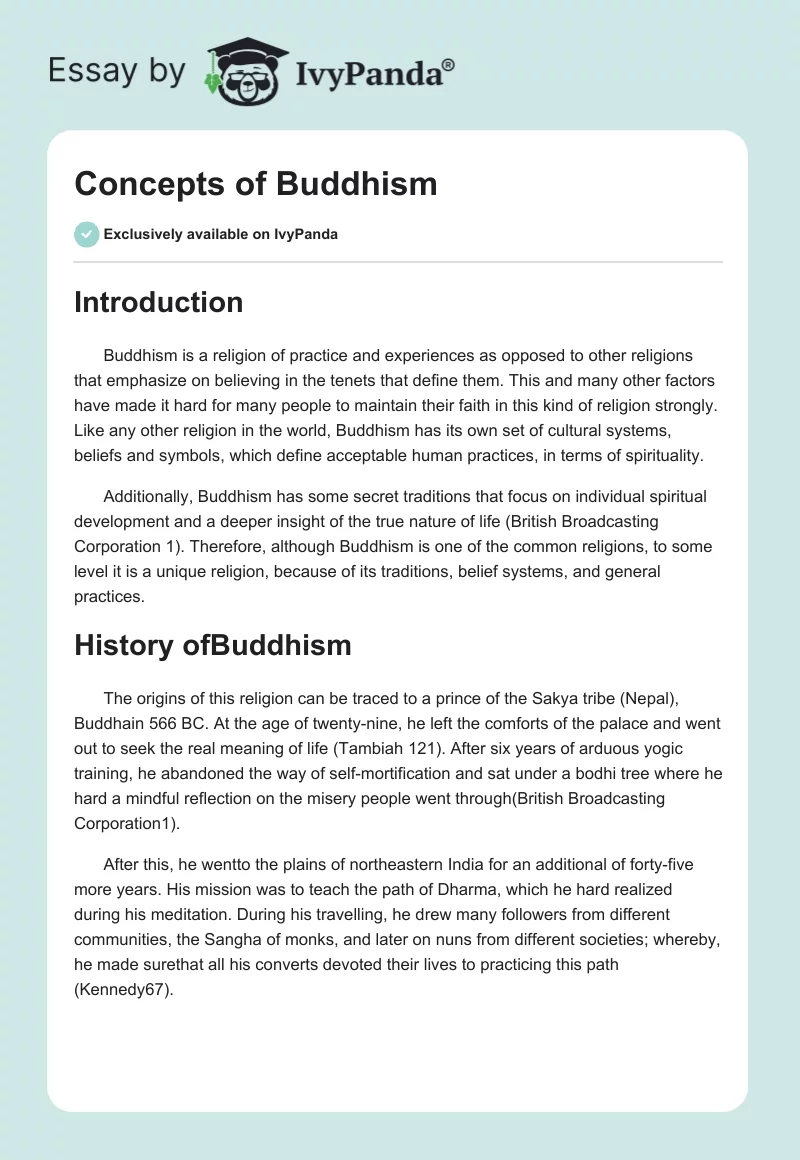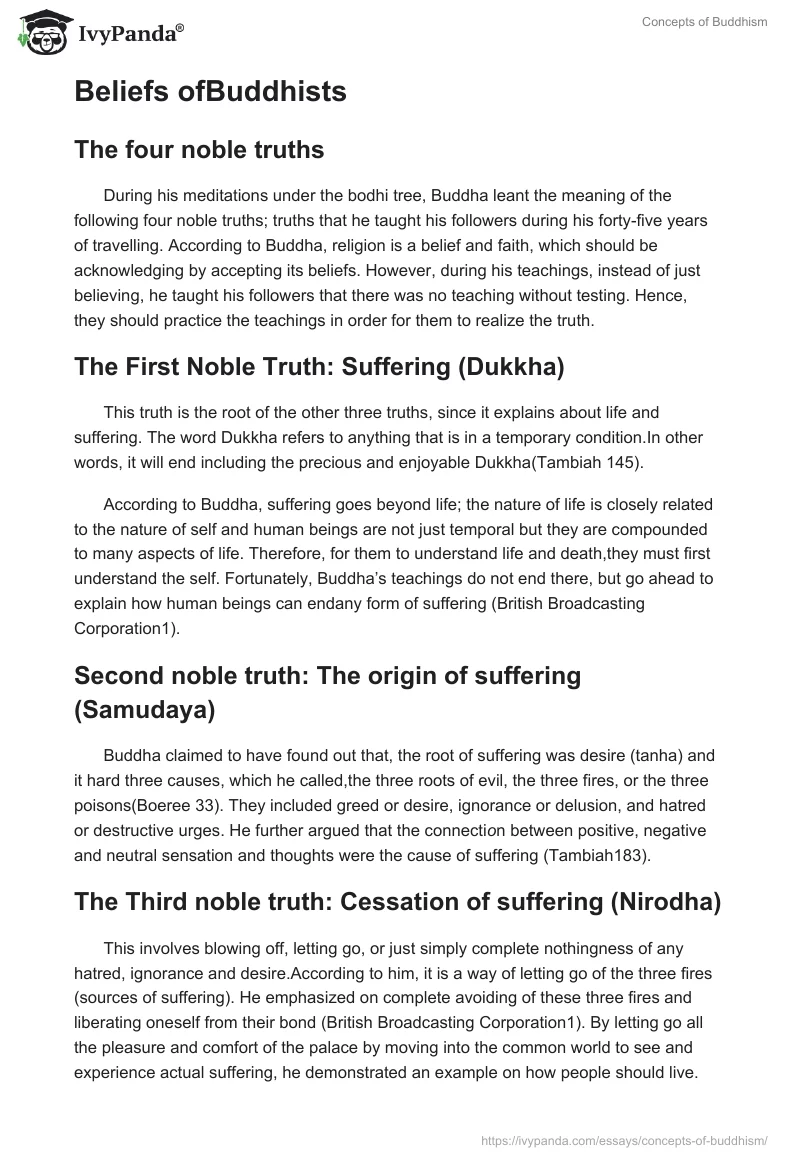Introduction
Buddhism is a religion of practice and experiences as opposed to other religions that emphasize on believing in the tenets that define them. This and many other factors have made it hard for many people to maintain their faith in this kind of religion strongly. Like any other religion in the world, Buddhism has its own set of cultural systems, beliefs and symbols, which define acceptable human practices, in terms of spirituality.
Additionally, Buddhism has some secret traditions that focus on individual spiritual development and a deeper insight of the true nature of life (British Broadcasting Corporation 1). Therefore, although Buddhism is one of the common religions, to some level it is a unique religion, because of its traditions, belief systems, and general practices.
History of Buddhism
The origins of this religion can be traced to a prince of the Sakya tribe (Nepal), Buddhain 566 BC. At the age of twenty-nine, he left the comforts of the palace and went out to seek the real meaning of life (Tambiah 121). After six years of arduous yogic training, he abandoned the way of self-mortification and sat under a bodhi tree where he hard a mindful reflection on the misery people went through(British Broadcasting Corporation1).
After this, he wentto the plains of northeastern India for an additional of forty-five more years. His mission was to teach the path of Dharma, which he hard realized during his meditation. During his travelling, he drew many followers from different communities, the Sangha of monks, and later on nuns from different societies; whereby, he made surethat all his converts devoted their lives to practicing this path (Kennedy67).
Beliefs of Buddhists
The four noble truths
During his meditations under the bodhi tree, Buddha leant the meaning of the following four noble truths; truths that he taught his followers during his forty-five years of travelling. According to Buddha, religion is a belief and faith, which should be acknowledging by accepting its beliefs. However, during his teachings, instead of just believing, he taught his followers that there was no teaching without testing. Hence, they should practice the teachings in order for them to realize the truth.
The First Noble Truth: Suffering (Dukkha)
This truth is the root of the other three truths, since it explains about life and suffering. The word Dukkha refers to anything that is in a temporary condition.In other words, it will end including the precious and enjoyable Dukkha(Tambiah 145).
According to Buddha, suffering goes beyond life; the nature of life is closely related to the nature of self and human beings are not just temporal but they are compounded to many aspects of life. Therefore, for them to understand life and death,they must first understand the self. Fortunately, Buddha’s teachings do not end there, but go ahead to explain how human beings can endany form of suffering (British Broadcasting Corporation1).
Second noble truth: The origin of suffering (Samudaya)
Buddha claimed to have found out that, the root of suffering was desire (tanha) and it hard three causes, which he called,the three roots of evil, the three fires, or the three poisons(Boeree 33). They included greed or desire, ignorance or delusion, and hatred or destructive urges. He further argued that the connection between positive, negative and neutral sensation and thoughts were the cause of suffering (Tambiah183).
The Third noble truth: Cessation of suffering (Nirodha)
This involves blowing off, letting go, or just simply complete nothingness of any hatred, ignorance and desire.According to him, it is a way of letting go of the three fires (sources of suffering). He emphasized on complete avoiding of these three fires and liberating oneself from their bond (British Broadcasting Corporation1). By letting go all the pleasure and comfort of the palace by moving into the common world to see and experience actual suffering, he demonstrated an example on how people should live.
Under this truth, Buddha introducedNirvana (extinguishing any attachment to the three “poisons” and the significance of reaching enlightenment. He spoke about birth and not so much about death and what happens after death, because all he wanted his followers to concentrate on was how to free their souls from the cycle of suffering (Bradley 1).
The Forth noble truth: Path to the cessation of suffering (Magga)
According to this, for individuals to end their anguish’s, they have to adhere to a set of principles that are known as the Eightfold Path (Boeree62).
This path had eight principles, which were symbolized by the wheel of Dharma. They were Samma ditthi (meaning the acceptance of Buddhist teaching and the right understanding of all the practices), Samma sankappa (right intention or commitment), Samma vaca (telling the truth, avoiding slander and gossip), and Samma kammanta (behaving peacefully and harmoniously).
Others were Samma Vayama (developing positive state of mind), Samma sati (being aware of one’s body sensations feelings and state of mind) and lastly Samma Samadhi (building mental focus that is important for this awareness). This was to act as the bridge or raft for crossing to the other side of enlightenment (Boeree 89).
Buddhists’ Ethics
To start with, by all means all believers and other individuals should refrain from any abortion related acts. Buddhists believe that, nobody has the right to annihilate life, because they assume that, causing death is immoral.
This religion is an animal friendly religion and it expects humans to treat animal with kindness, although in the three fires that causes suffering, it uses animal symbols. The second main principle ethic centers onpunishment.According to the teachings of this religion, there should no coalesced policy on capital punishment, because of the existence of different forms of Buddhism (Boeree 124).
Another ethic is on contraception.According to the teachings of this religion, it is ungodly to use any medicine that prevents conception, because the use of these drugs is a form of causing death (Tambiah200).In addition, according to this religion’s teachings, euthanasia and going to war is wrong. On the other hand, there are no rules about organ donations, but its followers look at it a way of stopping suffering or being charitable (Bradley 1).
Customs
One of the main customs of this religion is venerating the Buddha. This is a practice that that is respect, because it is taken to be a way of meditating and honoring the qualities of Buddha. Another custom is the sacred mandala. This comprises of a picture of the universe painted on a wall or on a scroll that represent an imaginary palace that the Buddhists reflect on during contemplation (Bradley 1).
The third common custom is meditation.According to this religion, the state of being mentally and physically involved in an action that detaches one from his or her thoughts and feelings, with an aim of becoming more aware.In addition to these, adherents of this faith also believe in worship.
They do worship from both home and temples, but at home, they set aside a room to serve as the shrine. This room has a statue of Buddha, a rile banner and some candles in front of the statue(Boeree 89).
Holly Days
On f the holy days of this religion is Dharma Day or Asalha Puja. Followers of this religion have set aside this day as one their holy days, because it marks the beginning of Buddha’s teachings after his enlightenment. This religion also celebrates Kathina Day. It is the oldest festive and it is the day at the end of the Vassa (monsoon period).
This day is commemorate to remind believers of this religion some of the places where the nomadic Buddhist spent their three months. In addition to these days, this religion has aLoser‘s day, which is day that marks the Tibetan New Year(Boeree 43).
On the other hand, buddhists celebrate Parinirvana Day, which is the day of the Mahayana festive that marks the death of the Buddha. Another holly day that is important to this religion is the Sangha Day. This is one of the most vital days in this religion, because it is celebrated to honor the Buddhist community(Boeree165).
Buddhism Demographics
Buddhism spread fast during the fourth and fifth century and currently it has over three hundred million followers in the world. Some of its sub-divisions are Korean Zen Buddhism, which has over eleven million followers and nine thousand temples, Mahayana Buddhism that is the strongest in Tibet, China, Taiwan, Japan and Mongolia.
Another subdivision is the Nichiren Buddhism, which is found majorly in Japan, although it also has a fast growing number of followers in the United Kingdom (Boeree 187) in addition to these, there is also Pure land Buddhism and Theravada Buddhism, which is the strongest in Sri Lanka, Cambodia, Thailand, Burma, and sections of Laos. Finally, there is Zen Buddhism, which a combination of Indian Mahayana Buddhism and Taoism from China, Korea and Japan, Tibetan Buddhism (Boeree174).
Conclusion
In conclusion, Buddhists do not worship gods or deities. This religion started more than two thousands five hundred years ago with just one leader (Siddhartha Gautama) and five followers, but presently, it has over three hundred and seventy six million followers globally (Bradley 1). This religion is one of the unique religions, because of its unique principles, teachings, and morals, which mainly focus on methods of alleviating human suffering, unlike other religions that emphasize on only how to live a righteous life.
Works Cited
Boeree, George. The Basics of Buddhism Wisdom. Pennsylvania : Shippensburg University Press, 1989. Web.
British Broadcasting Corporation. “Buddhism. BBC. Web.
Bradley, Cheryl. Buddha’s Trellis. Buddhism and the Tree of life. Tarot Canada. 2010. Web.
Kennedy, Chen. “Buddhism History.Buddhism in China. Pennsylvania : Princeton University Press, 1964. Print.
Tambiah, SJ. Essentials of Buddhism. (1976): 221. Web.


